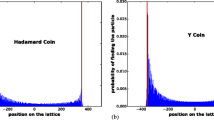Abstract
We study time operators for discrete-time quantum systems. Quantum walks are typical examples. We construct time operators for one-dimensional homogeneous quantum walks and determine their deficiency indices and spectra. Our time operators always have self-adjoint extensions. This is in contrast to the fact that time operators for continuous-time quantum systems generally have no self-adjoint extensions. The uniqueness of the extensions relates to the winding numbers corresponding to the system. If it is unique, its spectrum becomes a discrete set of real numbers, i.e., the time operator is quantized.
Similar content being viewed by others
References
Aharonov, Y., Bohm, D.: Time in the quantum theory and the uncertainty relation for time and energy. Phys. Rev. 122, 1649–1658 (1961)
Asbóth, J.K., Obuse, H.: Bulk-boundary correspondence for chiral symmetric quantum walks. Phys. Rev. B 88, 121406(R) (2013)
Arai, A.: Generalized weak Weyl relation and decay of quantum dynamics. Rev. Math. Phys. 17, 1071–1109 (2005)
Arai, A.: Spectrum of time operators. Lett. Math. Phys. 80, 211–221 (2007)
Arai, A.: Mathematical theory of time operators in quantum physics. RIMS Kôkyûroku 1609, 24–35 (2008)
Egusquiza, I.L., Muga, J.G.: Free-motion time-of-arrival operator and probability distribution. Phys. Rev. A 61, 012104 (1999)
Hiroshima, F., Kuribayashi, S., Matsuzawa, Y.: Strong time operators of generalized Hamiltonians. Lett. Math. Phys. 87, 115–123 (2009)
Jørgensen, P.T., Muhly, P.S.: Selfadjoint extensions satisfying the Weyl operator commutation relations. J. Anal. Math. 37, 46–99 (1980)
Miyamoto, M.: A generalized Weyl relation approach to the time operator and its connection to the survival probability. J. Math. Phys. 42, 1038–1052 (2001)
Murphy, G.: \(C^*\)-Algebras and Operator Theory. Academic Press, Cambridge (1990)
Pauli, W.: General Principles of Quantum Mechanics. Springer, Berlin (1980)
Sambou, D., de Aldecoa, R. Tiedra: Quantum time delay for unitary operators: general theory, Rev. Math. Phys. 31, 1950018 (2019)
Schmüdgen, K.: On the Heisenberg commutation relation. I. J. Funct. Anal. 50, 8–49 (1983)
Schmüdgen, K.: Unbounded Self-adjoint Operators on Hilbert Space. Graduate Texts in Mathematics, vol. 265. Springer, Berlin (2012)
Teranishi, N.: A note on time operators. Lett. Math. Phys. 106, 1259–1263 (2016)
Xiao, L., Qiu, X., Wang, K., Bian, Z., Zhan, X., Obuse, H., Sanders, B.C., Yi, W., Xue, P.: Higher winding number in a nonunitary photonic quantum walk. Phys. Rev. A 98, 063847 (2018)
Acknowledgements
The authors would like to thank the referees for constructive comments, which have been helpful to improve this paper. This work was supported by JSPS KAKENHI (Grant Number JP18K03327, JP16K17612 and 26800055), and by the Research Institute for Mathematical Sciences, a Joint Usage/ Research Center located in Kyoto University.
Author information
Authors and Affiliations
Corresponding author
Additional information
Publisher's Note
Springer Nature remains neutral with regard to jurisdictional claims in published maps and institutional affiliations.
A Fundamental properties of time operators of a unitary operator
A Fundamental properties of time operators of a unitary operator
The following are fundamental properties of time operators of a unitary operator.
Proposition A.1
Let T be a strong time operator of a unitary operator U. Then the following hold.
-
(1)
Its closure \({\bar{T}}\) is a strong time operator of U as well.
-
(2)
\([T,U]=U\) holds on a dense subspace D(T). In particular, T is a time operator of U. The converse is not true, i.e., not every time operator of U is a strong time operator of U.
-
(3)
\(\sigma (T)=\sigma (T+1)\) holds. In particular, T is unbounded.
-
(4)
If T is essentially self-adjoint, then \(\sigma (U)={\mathbb {T}}\)
Proof
(1) follows from a simple limiting argument. The first half of (2) is straightforward. For the second half of (2), see Example 4.6. (3) is obvious. We show (4). It follows that
for any \(t\in {\mathbb {R}}\). Thus, we obtain \(e^{it{\bar{T}}}Ue^{-it{\bar{T}}}=e^{it}U\). This means that \(\sigma (U)=\sigma (e^{it}U)\) for all \(t\in {\mathbb {R}}\). Hence, \(\sigma (U)={\mathbb {T}}\) holds. \(\square \)
Theorem A.2
Let U be a unitary operator admitting a strong time operator T. Then U has no eigenvalues.
Proof
The proof is same as the proof of [9, Corollary 4.3], and thus we omit it. \(\square \)
A strong time operator governs the decay rate of the transition probability as follows:
Theorem A.3
Let T be a strong time operator of a unitary operator U. Then for any \(n\in {\mathbb {N}}\), \(\psi \in D(T^n)\) and \(\phi \in D\bigl ((T^*)^n\bigr )\), there exists a constant \(C_n(\phi ,\psi )>0\) such that
holds.
Proof
The proof is same as the proof of [3, Theorem 8.5], and thus we omit it. \(\square \)
Rights and permissions
About this article
Cite this article
Funakawa, D., Matsuzawa, Y., Sasaki, I. et al. Time operators for quantum walks. Lett Math Phys 110, 2471–2490 (2020). https://doi.org/10.1007/s11005-020-01299-5
Received:
Revised:
Accepted:
Published:
Issue Date:
DOI: https://doi.org/10.1007/s11005-020-01299-5



